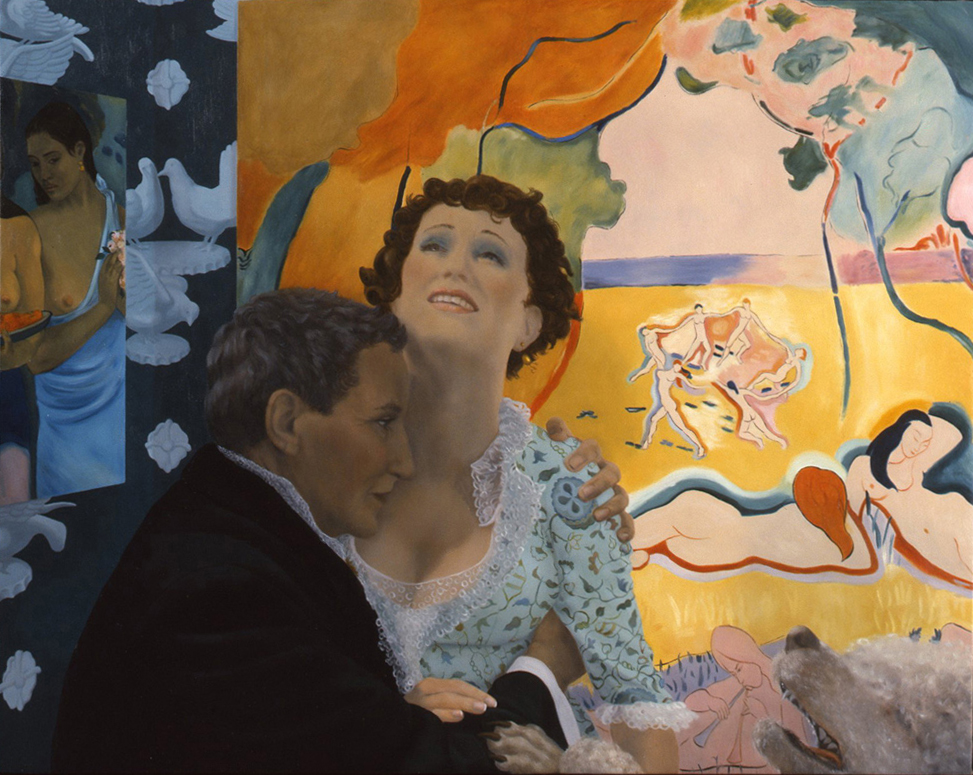On July 23, 1946, just before her diagnosis of stomach cancer and the surgery that ended her life, Gertrude Stein wrote her will. She left what little money she had and her priceless collection of paintings to her lover of decades, Alice B. Toklas.
Though acquired for a pittance at the turn of the century, Stein's modernist collection had become valuable -- the loaning out of it alone should have supported Toklas. But the late writer's relatives wanted the art -- all of it. While Toklas was away at a spa in Italy in 1961, they took the precious works, leaving her penniless and alone to stare at the outlines on the walls.
New York artist Hilary Harkness read about Toklas' misfortune in a series of New Yorker articles by veteran reporter Janet Malcolm. They roiled her; the unequivocal -- and often unabashed -- painter had been undergoing her own spousal dilemma and she took to the studio once again. Out of both emotion and action, came her latest series: "New Paintings," opening this week at the renowned Mary Boone gallery.

"New Paintings", of which the Stein and Toklas works play a major role, illustrate, among other things, lesbians' place in post-World War II. Through the biographical images, Harkness depicts the couple's transgressive, yet tortured relationship, posh, yet cloistered life, flight from persecution, yet ultimate submission to it.
"Outside of New York and certain other cities, lesbian couples have the same problems they had 100 years ago," said Harkness, a native of Detroit. "Even though it seems less relevant now with all the media surrounding these issues, my job is still to put my reality down.
"Aside from donating money to the cause, all I've been able to do is paint. As an artist, I am throwing my two cents into the discourse."
Harkness is not the only one. As they did during the women's movement and the early gay rights mobilization, lesbian artists are painting, photographing and sculpting their place in the marriage debate. Since the New York State legislature denied gays and lesbians the right to marry in December 2009, lesbian photographer Alix Smith has taken her series "States of Union" to much acclaim at New York and Connecticut's Morgan Lehman Gallery. And artist Nicole Eisenmann -- a painter whose name is spoken in the same sentences as George Condo, John Currin and Elizabeth Peyton -- has depicted scenes of lesbian family life with her partner, Victoria Robinson, at the Leo Koenig gallery.
"Art has the ability to affect opinions and perceptions. The more the world is permeated with images of gay and lesbian couples and families, the harder it will be for same-sex relationships to be considered 'other,'" Smith said. "What I find most satisfying about photography is the way in which it allows me to document 'reality' while at the same time creating my own version thereof.
"But the work is directly inspired by the lack of official recognition and documentation of same-sex couples and families."
Harkness' show - her fourth solo exhibition -- builds upon themes and the key symbols in her previous work, but adds, for the first time, the actual lived experience of historical actors. For her own apolitical-political statement, Stein and Toklas seemed the obvious choice.
"I was born in '71 and during that time, in the Midwest, we had no lesbian role models," said Harkness, who now divides her time between the Lower East Side and Boston, where her current girlfriend lives. "I had lesbian neighbors of whose relations were never spoken -- my parents felt they needed to protect me from the knowledge of those relationships.
"Alice and Gertrude had a strong bond -- Alice served Gertrude her entire life. And it was overlooked by society."
Also grouped in the school of Condo and Currin, Harkness riffs off Old Master with the best of them. "Morning Glory" is a portrait of a flat, sexually frustrated Alice staring off canvas while Gertrude lovingly dotes on her poodle Basket; "Pleasing Papa" features a leering Ernest Hemingway -- a protégé-turned-adversary of Stein's -- flanked by both women at a bar with Gertrude in drag; and "Alice at Loggerheads" is another portrait of a vexed Alice, drinking, contemplating and snuffing her cigarettes into an upturned seashell, a traditional symbol of fertility.
"For me, these paintings became all about the discomfort about having to fit into the dominant straight culture -- about fitting into a patriarchal culture," Harkness said.
"Painting really is a safe thing, a safe means of expressing myself. A lot of stuff goes on in my paintings that I would never do and people buy it to live vicariously. A feminist painting still has power."
"Hilary Harkness: New Paintings, will run through 25 June 2011 at the gallery's Midtown location, 745 Fifth Ave. For further information, please visit www.maryboonegallery.com.
